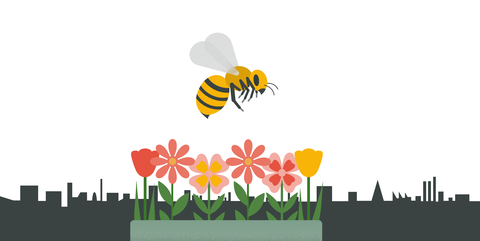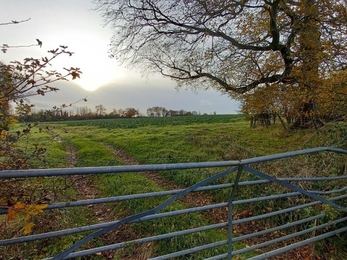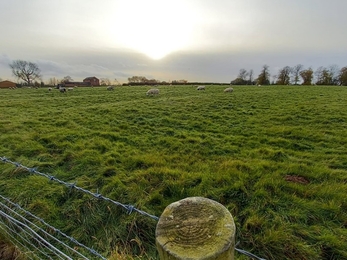
Celebrating two new sites to create vital homes for wildlife in our county.
In response to the escalating ecological crisis, 2021 saw the launch of our Nature Recovery Fund with the aim of buying land, transforming habitats and reconnecting people with nature at a scale we have not done before. We were after those missing pieces. Land low in value for nature to help it to thrive, creating new homes for wildlife.
We are delighted to say we have been successful in buying land and making more space for nature, the size of 65 football pitches!
Sheep Field
Right next to Brandon Marsh, a 23-ha piece of land locally know as ‘Sheep Field’ is the missing piece of the nature jigsaw connecting Brandon Marsh, Brandon Reach, Brandon Wood and the old Brandon Wood golf course. Before the purchase the land was under threat of development, which would have impacted the wildlife in the surrounding area.
Sheep Field is currently in poor condition for nature, giving us the perfect opportunity to improve it over time. Extensive quarrying for mineral products carved chunks out of the land and depleted its quality. The quarry site closed over 20 years ago, and the holes filled with inert material and topped with soil. Despite this, the land never returned to its original level so sits as a damp hollow with a series of streams and ditches crisscrossing the site. The open grassland has scrubbed over to a uniform make up of willow and hawthorn, broken up with small oaks trees voluntarily planted by species like jays, who have dropped acorns as they fly between Brandon Woods and Brandon Marsh. If it stays this way, it will lose the value in structure and diversity of the habitats.
Tarmac sold the site to Warwickshire Wildlife Trust, and we are grateful they took into consideration our ambitions for nature in the landscape around Brandon Marsh. Thanks to this purchase, Warwickshire Wildlife Trust now owns or manages over 200 hectares of land for wildlife and people in the Brandon area, alongside a further 70 hectares of woodland in Brandon Wood and 15 ha of mixed habitats in Steetley Meadows.
We plan to enhance the grassland and woodland habitats on Sheep Field, welcoming in a variety of wild and wonderful creatures and creating a mosaic of habitats across a huge amount of land on the doorstep of Coventry.
Knowing we were going to still be neighbours to the new landowners, we felt that selling the land to Warwickshire Wildlife Trust safeguarded the land for the future and helped in their mission to bring nature back through acquiring land for nature’s recovery. We are keen to see what plans the Trust has in store and can see the potential in the land to do that.
Clayhill Lane
Situated north of the village of Long Lawford, Clayhill Lane has a long history of agricultural production. The 20-ha site consists of bare arable land and grazed fields, intermingled with a network of hedgerows and small patches of woodland.
Currently it is a blank canvas with huge potential for supporting an increase in the amount and diversity of species. Surveying is currently underway, but we know the site isn’t widely used by wildlife due to the intensive nature of past agriculture. By creating and enhancing habitats, increasing tree cover to complement the existing network of mature hedgerows and improving the meadows, the mix of arable and pasture could welcome hares and birds of prey like red kites.
The river Avon winds its way along the northern boundary, providing opportunities for wetland creation which will help species like otters to pass through the landscape, and provide stepping stones for creatures looking for homes, food and the chance to breed. The river often floods, which could allow us to create floodplain grasslands to buffer the river and improve the site for wetland and grassland wildlife.
The land was sold to the Trust by The Barnes family, who have been incredibly supportive of our plans and who continue to help us with grazing and management as we transition the site to the Trust’s care. We look forward to working closely with them in the future.
We are excited about Clayhill Lane’s potential for rapidly developing into a nature hot spot and a vital wildlife ‘service station’ between our reserves at the source of the Avon, and Brandon Marsh and Brandon Reach.

Red kite by Andy Rouse 2020VISION
The road to new land
In 1970, when Warwickshire Wildlife Trust was formed, passionate local people came together at a time of crisis to protect and preserve precious wildlife sites under threat from development. If you’ve ever been lucky enough to see the spectacular carpet of bluebells in Ryton Wood or witness a dawn chorus at Leam Valley, you’ll know those sites are special. The relics of a landscape once teeming with diverse wildlife.
Despite protecting pockets of land, local wildlife populations continue to decline, and that decline is accelerating. It was no longer enough to protect, we needed to create, acting with ambition and at scale.
The road to new land has been a challenging one. Since 2021 we have considered 32 sites totalling 1,277 hectares of land. The Trust bid on seven of the 32 sites that were the best fit for our strategy, but it’s a competitive market out there. There have been challenges, setbacks and disappointments along the way, however we stuck to our course and with determination and a huge amount of hard work, we got there!
Our two new sites, brought under the Trust’s care, will create strategically important homes for wildlife in the right places.
A landscape connected for nature
We know that for nature to thrive, it needs to be able to move freely across a range of connected habitats that support a diverse range of life. This vision for nature corridors is falling into place, right on the doorstep of Coventry, with Brandon Marsh at the heart of it.
By managing our own reserves, buying new sites, and working in partnership with others on their land we are supporting a nature recovery network that covers everything from woodlands to meadows, rivers to marshes and wetlands to grasslands.
Our focus now is to bring the new sites to life and weave them together more closely with their neighbouring green spaces. This will strengthen those all-important nature recovery networks that allow plants and animals to move from place to place and create the new habitat they need to respond to climate change.
A heartfelt thank you
Thank you to our members and supporters who gave incredibly generously, donating over £230k to the Nature Recovery Fund. Every penny of which has gone to support the two purchases at Sheep Field and Clayhill Lane. Over 700 people contributed, and alongside profit allocated by Trustees from our environmental consultancy company, Middlemarch, and generous legacies left to Warwickshire Wildlife Trust, the total stood at just over £2.7m before those purchases – a massive achievement.
We would like to thank National Grid, who donated £92k towards the purchase of Clayhill Lane to support delivery of their sustainability commitments and to enable nature’s recovery. Thanks also to Waitrose who supported the appeal through their ‘Give a Little Love’ scheme. Thanks also go to The Saintbury Trust, the William A. Cadbury Charitable Trust and the Langdale Trust for their generous donations to the Nature Recovery Fund that have supported the purchase of both sites. Finally, we’d like to thank our land agents, Bidwells, and solicitors HCR Hewitsons LLP and Wright Hassall LLP.






